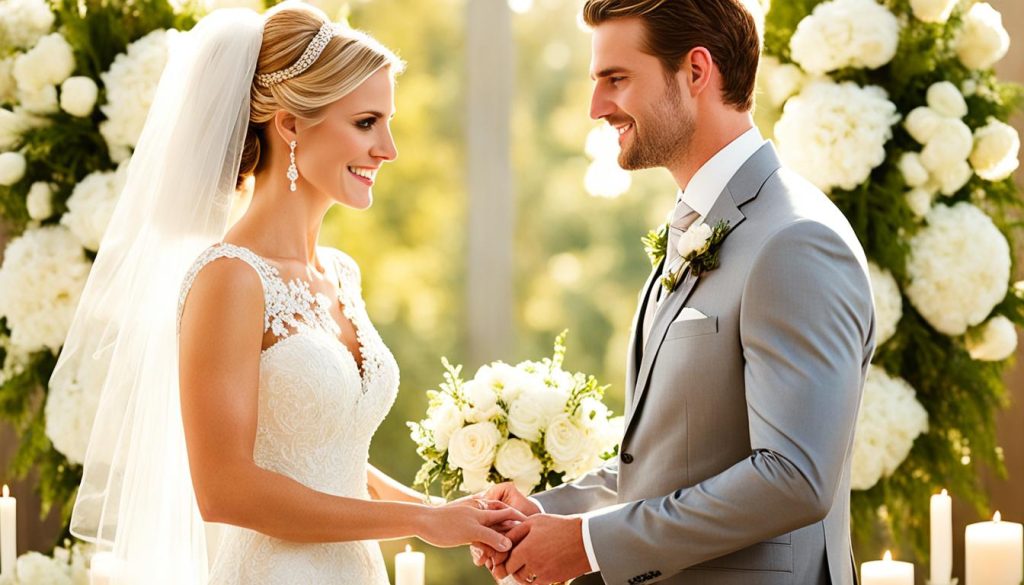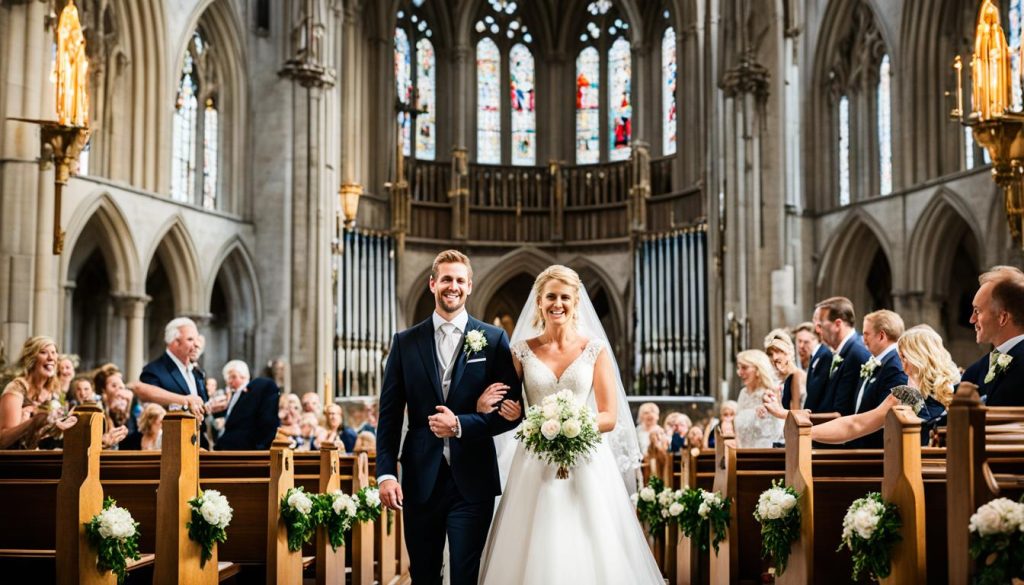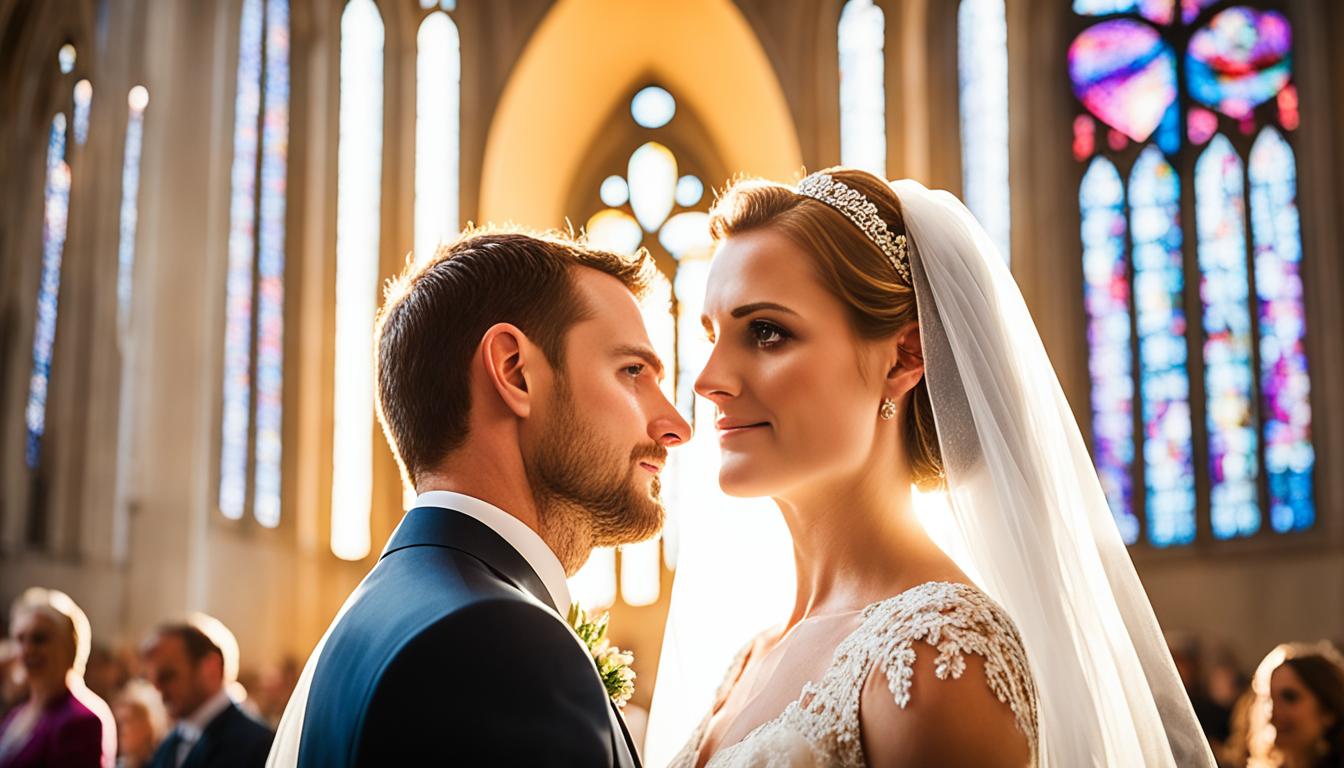When the vows are said within the enchanting confines of a church, lighting can be the silent artist that turns a moment into a masterpiece. This guide will shed light on essential church wedding photography lighting tips to help you capture the sacred union with the beauty it deserves. Whether you are mastering the use of natural sunlight streaming through stained glass or delicately balancing artificial sources, we’ll show you how to create beautiful church wedding photos with lighting. Our practical church wedding photography lighting ideas will steer you through the sanctified aisles to create luminous memories that last a lifetime.
Key Takeaways
- Understand the unique qualities of church lighting environments.
- Integrate both natural and artificial lighting sources to enhance imagery.
- Adopt necessary gear and techniques for difficult lighting scenarios.
- Respect the sacred ambiance when adjusting lighting for photography.
- Use light strategically to add depth and emotion to wedding photos.
- Remain adaptable to the dynamic lighting within church settings.
Understanding the Unique Lighting Challenges in Churches
Churches, with their solemn and ornate interiors, present a specific set of considerations for photographers. The unique lighting challenges in churches often stem from the sanctified architecture and the ambient conditions, which hold a significant impact on wedding photography. In this section, we delve into strategies and insights that will help photographers overcome these hurdles, ensuring that each captured moment is both divine and beautifully lit.
Dealing with Low Light Environments
In many churches, photographers encounter low light environments that can test the limits of their equipment and skills. To tackle these conditions, it’s essential to adjust camera settings for optimal exposure. This might include increasing ISO, employing wider apertures, or slowing down the shutter speed. Beyond camera tweaks, photographers can also utilize available light resources, such as strategically positioned candles or ambient church lighting, to enhance the scene without detracting from the atmosphere.
The Impact of Stained Glass and Ornate Structures
Stained glass windows and intricate architectural details are hallmarks of church design, but they also pose unique lighting challenges in churches. These features can create dynamic and colored light patterns that are tricky to balance. By understanding the direction and quality of light streaming through stained glass, photographers can use these vibrant hues to their advantage, creating compelling images that celebrate the kaleidoscopic beauty of these elements.
Respecting the Sacred Ambiance While Shooting
Respecting the sacred ambiance while shooting in churches is paramount. It’s not just about finding the right lighting—it’s also about maintaining the reverence of the space. Quiet, unobtrusive methods are key; for instance, using remote triggers for flashes or soft continuous lighting can reduce disruptions during solemn moments. Photographers must blend technical know-how with a sensitive approach to capture the essence of the occasion while honoring the spiritual significance of the setting.
| Challenge | Strategies | Benefits |
|---|---|---|
| Low Light Environments | Adjust ISO, aperture, and utilize ambient light | Enhanced details and atmosphere without intrusive lighting |
| Stained Glass Illumination | Study light patterns and adjust white balance | Images with vibrant, natural coloration and visual interest |
| Sacred Ambiance Preservation | Employ quiet and non-disruptive lighting techniques | Respectful captures that reflect the sanctity of the venue |
Professional photographers tasked with preserving life’s treasured moments understand that navigating the low light environments in churches, working with the stained glass and ornate structures in churches, and respecting the sacred ambiance while shooting in churches are all crucial to achieving stunning and meaningful photographs.
Mastering Natural Lighting for Indoor Wedding Photography

The dynamic interplay of shadows and highlights can define the mood of any wedding photograph. Mastering natural lighting for indoor wedding photography not only requires a perceptive eye but also a deep understanding of how light behaves within the confines of a space. Capturing the essence of a subject is paramount, and here we delve into the indoor wedding photography lighting tips that will help you do so.
Observation is key when it comes to utilizing natural light. One must take note of the direction from which the light enters the room and at what intensity at different times of the day. These factors greatly influence the final image. Reflective surfaces, such as walls, mirrors, and even the floor, can serve as tools to bounce and diffuse light, softening harsh shadows and creating a flattering glow on the subjects.
Positioning is just as crucial. A well-lit background can elevate a subject, while a poorly lit one can detract from the moment captured. Subjects placed at strategic points where natural light is most abundant will not only be illuminated effectively but will also be endowed with a radiant, ethereal quality that is highly sought after in wedding photography.
- Make the most out of the golden hour, when natural light is soft and warm, for a romantic ambiance.
- Utilize sheer curtains to diffuse harsh sunlight and create a uniform light source.
- Spot positions where indirect light provides a soft glow without casting strong shadows.
The importance of harnessing natural light cannot be overstated, and a photographer’s ability to do so can transform a simple photograph into a work of art. The ensuing table provides a snapshot of tips for managing natural light:
| Scenario | Challenge | Solution |
|---|---|---|
| Direct sunlight entering through large windows | Risk of overexposure and harsh shadows | Use curtains or position subjects at an angle to soften the light |
| Cloudy day with diffuse natural light | Flat lighting with reduced contrast | Enhance features with subtle artificial light if necessary |
| Interior with mixed lighting conditions | Inconsistent light can affect white balance | Adjust camera settings or use reflectors to manage the light blend |
By considering these indoor wedding photography lighting tips, photographers can skillfully master the subtleties of natural light to deliver stunning indoor wedding photos that preserve the magic of the couple’s special day for a lifetime.
Best Lighting Setup for Church Weddings
Creating the best lighting setup for church weddings is about balancing art with technical savvy. A sacred atmosphere, highlighting intimate moments, and revealing the architectural beauty of the space—it all comes down to how effectively you utilize the available light resources for church weddings and incorporate additional lighting equipment.
Utilizing Available Light Resources
Most churches are adorned with intrinsic sources of light such as chandeliers, candles, and occasionally spotlights. These available light resources can serve as the backbone for your photography lighting, offering a warm and authentic ambience that is difficult to replicate with artificial light.
Choosing the Right Equipment for Church Wedding Photography
Whether it’s diffused flash or continuous lights, choosing the right equipment for church wedding photography is crucial. Reliable flash units, a range of modifiers like umbrellas and softboxes, and perhaps a sturdy monopod can give you the flexibility to shoot in varying light without missing a beat.
Positioning Lights for Optimal Illumination
The strategy for positioning lights for optimal illumination requires thoughtful consideration. The goal is to complement the natural light, minimize harsh shadows, and avoid disrupting the ceremony. Sometimes, the best position for light stands is towards the sides or behind pillars, subtly out of sight yet effective in enhancing the scene.
| Equipment Type | Usage | Benefit |
|---|---|---|
| On-camera Flash | Fill light for subjects | Add clarity to faces, diminish shadows |
| Modifiers (Softbox, Umbrella) | Diffuse flash light | Soften light, enrich natural ambiance |
| LED Panels | Continuous light source | Immediate WYSIWYG setup, color matching |
| Monopod | Support for heavier gear | Enhanced stability, mobility for photographer |
Church Wedding Photography Lighting Tips

Unlock the full potential of your church wedding photography lighting tips with expert strategies to illuminate your images. Mastering wedding photography lighting techniques within the serene confines of a church requires a special touch—balancing reverence for the space with the technical demands of photography.
Adjusting camera settings is fundamental in managing different lighting conditions, whether that be the harsh midafternoon sun streaming through stained glass or the subtle hues of a candlelit evening ceremony. Spotting the perfect exposure can be achieved with the aid of light meters, ensuring that your photographs reflect the mood and ambiance of these solemn moments.
Alongside precision, there’s an undeniable need for softness, and that’s where the use of diffusers comes into play. To avoid overly harsh lighting on your subjects, diffusers can soften the flash, lending a more natural and gentle look to the final image. Not to be overlooked, creative lighting methods such as backlighting and silhouette photography coax out an artistic flavor that adds an illustrious edge to your portfolio of church wedding photos.
To illustrate these concepts, let’s look at a table comparing different church environments and suitable lighting techniques:
| Church Environment | Lighting Technique | Equipment/Tips |
|---|---|---|
| High Ceilings with Dim Lighting | Expose for Ambiance | Use a tripod for stability and longer exposures |
| Bright Stained Glass Windows | Diffused Backlighting | Position subjects with the light source behind them |
| Candlelit Altar | Soft Flash with Diffusers | Attach a softbox or bounce card to your flash unit |
| Sunny Day with Harsh Shadows | Fill Flash Techniques | Balanced use of flash to mitigate shadow contrast |
Finally, no church wedding photography course would be complete without emphasizing the gold standard of lighting practices: trial and error. Only through hands-on experience and a constant willingness to learn can you truly master the delightful interplay of light and shadow that church weddings offer. Capture the sanctity and joy of these moments with confidence and finesse, becoming the conduit between raw emotion and timeless memory.
Advanced Wedding Photography Lighting Techniques
Delving into the world of church wedding photography requires a command of lighting that goes beyond the basics. As we journey through this section, we explore the elements of advanced wedding photography lighting techniques that elevate your work to a professional standard. Crafting the perfect shot often hinges on the nuanced interplay between light and shadow, essential for a vibrant and emotionally resonant capture.
Using Bounce Flash to Soften Shadows
Unwanted shadows can be a photographer’s nemesis, often obscuring fine details or creating harsh contrasts. By using bounce flash to soften shadows, photographers can diffuse light and impart a gentle, even exposure on the subjects. The key is to angle your flash towards a neutral surface, like a ceiling or wall, allowing the light to scatter before it reaches the scene. This technique doesn’t just diminish shadows but also adds a dimensional quality to the photographs.
Implementing Off-Camera Flash Strategies
The strategic use of off-camera flash strategies empowers photographers to step outside the box of traditional lighting. Positioning a flash unit off to the side or behind the subject can create dynamic lighting, casting a more compelling image. The off-camera flash offers heightened control of lighting direction and strength, enabling wedding photographers to sculpt the scene with light and produce a more curated aesthetic.
Balancing Flash with Ambient Light
A crucial aspect of mastering wedding photography lighting lies in balancing flash with ambient light. The key is to maintain the delicate equilibrium between the two, ensuring your flash complements rather than overpowers the existing light. Adjusting flash power and shutter speed to marry the natural and artificial lights can yield images with a seamless, natural ambiance.
It’s essential for wedding photographers to also consider the color temperature when combining flash with ambient lighting. Flashes typically emit a cooler tone, so modifying color balance through gels or in post-processing is often needed to achieve consistency.
| Technique | Benefits | Best Use Scenarios |
|---|---|---|
| Bounce Flash | Softer light, reduced shadows | Indoor with reflective surfaces |
| Off-Camera Flash | Directional control, creative lighting | Outdoor twilight, backlighting subjects |
| Flash and Ambient Light Balance | Natural blend, accurate color representation | Scenes with mixed lighting conditions |
Armed with these advanced wedding photography lighting techniques, professionals can capture the magic of church ceremonies with confidence. The mastery of using bounce flash to soften shadows, off-camera flash strategies, and balancing flash with ambient light not only enhances the photo quality but also drastically improves storytelling through images. So, harness these tactics and let the wedding ceremonies shine in their true, illuminated splendor.
Capturing Perfect Church Wedding Photography Poses with Natural Light
Unlocking the secret to capturing perfect church wedding photography poses with natural light starts with an in-depth understanding of the church’s architecture. The intricate designs of churches often allow light to filter through in a truly magical way, providing a soft and ethereal backdrop for your photographs. By positioning the couple near large windows or under the soft glow of a skylight, you can harness this light to highlight their features and create a serene ambiance. It’s crucial to take the time to observe how natural light flows through the space and to adjust your compositions accordingly, ensuring each pose is lit to its fullest potential.
When considering natural light poses for church wedding photography, it is beneficial to conduct a walkthrough of the venue prior to the wedding day. Observing the way light interacts with the unique elements of the church at different times can inform decisions on where and when to stage your most important shots. Directing your subjects to face towards the light can illuminate their expressions and add depth to their attire. The interplay of light and shadow can create dynamic contrasts, highlighting emotional moments and sculptural details in their clothing, bringing a sense of depth and drama to your imagery.
Posing the wedding party with natural lighting also requires an attentiveness to the mood you aim to create. A soft backlight can create a halo effect, adding an almost divine quality to the images, fitting for the sacred setting. By using reflective surfaces like polished floors or light-colored walls, you can achieve even lighting on the faces of your subjects, which is particularly flattering for close-up shots. Remember, mastering natural light poses for church wedding photography is as much about anticipating the light’s behavior as it is about creatively adapting to it. As you explore the venue and interact with your subjects, maintain a balance between posed and candid shots to capture the genuine joy of the day under the benevolent glow of natural light.






